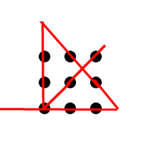Try thinking beyond conventional boundaries or norms. The significance of the numbers in this sequence extends beyond their numerical value. Instead, they represent the length of each word in the sequence, starting with the number one. The sequence is as follows: 3, 3, 5, 4, 4, 3, 5, 5, 4, 3, 6, 6. The last number, 6, corresponds to the word “twelve,” which consists of six letters. Consequently, the subsequent three numbers, 8, 8, and 7, illustrate the number of letters in the words “thirteen,” “fourteen,” and “fifteen,” respectively.
